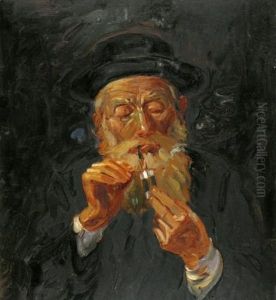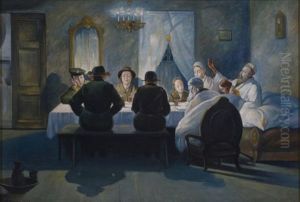Abraham Jozef Messer Paintings
Abraham Jozef Messer was a Polish Jewish painter born on July 15, 1891, in Warsaw, Poland, which at the time was part of the Russian Empire. He grew up in a period where Poland had a strong tradition of visual arts, which was influenced by both Western European and Russian art movements. Messer was part of a community that experienced significant changes and challenges during his lifetime, including the First World War, the rebirth of Poland as an independent nation in 1918, and the rise of modernism in art.
Messer's art education and early career developed in the milieu of the vibrant Polish art scene. He likely received his initial training at the Warsaw School of Fine Arts, which was a common path for Polish artists at that time. His style would have been influenced by the various movements of the early 20th century, such as Expressionism, Constructivism, and perhaps the Polish form of Art Nouveau, known as Young Poland (Młoda Polska).
During the interwar period, Messer's work would have been part of the broader trends in Polish art, which included a focus on national identity and the exploration of avant-garde European art forms. Artists of his generation were searching for a modern Polish artistic language that could express the complexities of the interwar years, a time of both optimism and anxiety as Poland navigated its newfound independence and the pressures of modernity.
The outbreak of the Second World War in 1939 had a profound impact on Messer’s life and career. As a Polish Jew, he faced the horrors of the Holocaust. Tragically, Abraham Jozef Messer was murdered in 1942 during the Holocaust. The exact circumstances of his death are not well-documented, which is a fate shared by many artists and intellectuals who were victims of the Nazi regime.
Due to the destruction wrought by the war and the loss of many records, details about Messer's artistic achievements are scarce. Much of his work may have been destroyed or lost during the wartime period, leaving a limited legacy for art historians to study. Despite this, Messer remains a figure of interest, representing the generation of Eastern European Jewish artists whose lives and careers were cut short by the war. His story is a poignant reminder of the cultural losses suffered during this dark chapter of history.

